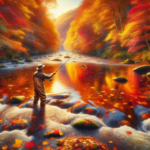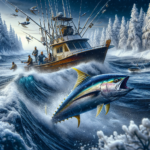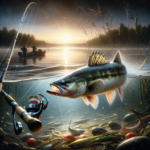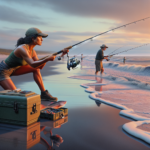Spring Trout Fishing in Colorado’s Mountain Rivers
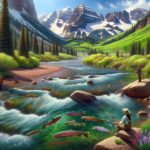
Introduction
Imagine standing knee-deep in a crystal-clear mountain river, surrounded by the breathtaking scenery of Colorado’s Rockies, as you cast your line in hopes of catching a prized trout. Did you know that Colorado boasts over 9,000 miles of trout streams and more than 2,000 lakes and reservoirs? This makes it a premier destination for anglers, especially during the spring season when trout fishing is at its peak.
In this article, we will delve into the intricacies of spring trout fishing in Colorado’s mountain rivers. We will cover everything from the best fishing techniques and gear recommendations to the top fishing spots and seasonal considerations. Whether you’re a seasoned angler or a novice looking to try your hand at trout fishing, this guide will provide you with the knowledge and tips you need for a successful fishing trip.
Understanding the nuances of spring trout fishing in Colorado is crucial for maximizing your chances of a good catch. This article will help you navigate the best fishing spots, master effective techniques, and ensure you are well-prepared for your fishing adventure.
Background/Context
Historical or Cultural Significance
Trout fishing has deep roots in Colorado’s history and culture. Native American tribes, such as the Ute and Arapaho, relied on the state’s rivers and streams for sustenance. With the arrival of European settlers, trout fishing evolved into both a recreational activity and a means of livelihood. Today, it remains a cherished pastime, drawing anglers from around the world to Colorado’s pristine waters.
Geographical Overview
Colorado’s mountain rivers are characterized by their clear, cold waters, which are ideal for trout. The state’s diverse topography includes the Rocky Mountains, which provide a stunning backdrop for fishing. The climate varies with altitude, but spring typically brings milder temperatures and increased water flow from snowmelt, creating optimal conditions for trout fishing. The local ecosystem is rich with aquatic insects, which serve as a primary food source for trout.
Key Points/Details
Fishing Techniques
Technique Overview
Fly fishing is the most popular technique for trout fishing in Colorado’s mountain rivers. This method involves using a lightweight lure, known as a fly, to mimic the appearance of insects that trout feed on. Other effective techniques include spin fishing and bait fishing.
When and Where to Use
Fly fishing is particularly effective in fast-moving waters and during hatches when insects are abundant. Spin fishing can be used in both fast and slow-moving waters, while bait fishing is best suited for deeper pools and slower currents. Specific spots like the South Platte River, Arkansas River, and Gunnison River are renowned for their excellent trout fishing opportunities.
Recommended Gear
- Fly Rod: A 9-foot, 5-weight rod is versatile for most conditions.
- Reel: A quality reel with a smooth drag system.
- Line: Floating line for most situations, with sinking line for deeper waters.
- Flies: Dry flies, nymphs, and streamers to match local insect hatches.
- Waders: Breathable waders for comfort and mobility.
Species Information
Species Overview
Colorado’s mountain rivers are home to several trout species, including rainbow trout, brown trout, brook trout, and cutthroat trout. Each species has unique habits and preferred habitats. For example, rainbow trout are often found in fast-moving waters, while brown trout prefer deeper pools and undercut banks.
Best Practices
To successfully catch trout, it’s essential to match your fly or bait to the local insect population. Pay attention to the water temperature and flow, as these factors influence trout behavior. Early morning and late evening are typically the best times to fish, as trout are more active during these periods.
Location Information
Top Fishing Spots
- South Platte River: Known for its large rainbow and brown trout, with easy access points and amenities.
- Arkansas River: Offers diverse fishing conditions and a healthy population of brown trout.
- Gunnison River: Famous for its trophy-sized trout and stunning canyon scenery.
Regulations and Licenses
Anglers must have a valid Colorado fishing license, which can be purchased online or at local retailers. Be sure to check local regulations, as some areas have specific catch limits, seasonal restrictions, and gear requirements to protect fish populations and habitats.
Seasonal Considerations
Seasonal Variations
Spring is an excellent time for trout fishing in Colorado, as the increased water flow from snowmelt brings more food into the rivers, making trout more active. However, water levels can be high and fast, so anglers may need to adjust their techniques and gear accordingly.
Best Times to Fish
The optimal times to fish are early morning and late evening when trout are most active. Overcast days can also be productive, as trout are less wary and more likely to feed near the surface.
Events and Tournaments
Event Overview
Colorado hosts several fishing events and tournaments throughout the year. The annual “Trout Unlimited” tournament on the South Platte River is a popular event that attracts anglers from across the country. Other notable events include the “Arkansas River Fly Fishing Tournament” and the “Gunnison River Trout Derby.”
Preparation Tips
To prepare for a fishing event, ensure your gear is in top condition and practice your casting techniques. Research the specific river conditions and local insect hatches to select the appropriate flies or bait. Arrive early to secure a good fishing spot and familiarize yourself with the tournament rules and regulations.
Tips and Best Practices
General Tips
- Always match your fly or bait to the local insect population.
- Pay attention to water temperature and flow, as these factors influence trout behavior.
- Practice catch and release to help preserve fish populations.
Avoid Common Mistakes
- Using the wrong size or type of fly: Always carry a variety of flies to match local hatches.
- Fishing during the wrong time of day: Focus on early morning and late evening when trout are most active.
- Ignoring local regulations: Always check and follow local fishing regulations to avoid fines and protect fish populations.
Advanced Techniques
- Nymphing: Use weighted nymphs to fish deeper waters where trout often feed.
- Streamer Fishing: Mimic small fish or leeches to attract larger trout.
- Dry-Dropper Rig: Combine a dry fly with a nymph to cover both surface and subsurface feeding zones.
Gear and Equipment Recommendations
Essential Gear
- Fly rod and reel
- Floating and sinking lines
- Variety of flies (dry flies, nymphs, streamers)
- Breathable waders and wading boots
- Polarized sunglasses
Optional Gear/Upgrades
- Fishing vest or pack for carrying gear
- Wading staff for stability in fast-moving waters
- Waterproof camera for capturing your catch
Where to Buy or Rent
Local shops such as “Trout’s Fly Fishing” in Denver and “Angler’s Covey” in Colorado Springs offer a wide range of gear for purchase or rent. Online retailers like Orvis and Cabela’s also provide extensive selections of fishing equipment.
Safety and Conservation
Safety Tips
- Always check weather conditions before heading out.
- Wear a life jacket when fishing in fast-moving waters.
- Be aware of wildlife, including bears and snakes, and know how to respond to encounters.
Conservation Practices
- Practice catch and release to help maintain fish populations.
- Respect local wildlife and habitats by minimizing your impact on the environment.
- Follow all fishing regulations and guidelines to ensure sustainable fishing practices.
Planning Your Trip
Accommodations
There are numerous lodging options near Colorado’s top fishing spots. For example, the “South Platte River Cabins” offer comfortable accommodations near the river, while the “Gunnison River Lodge” provides easy access to prime fishing areas.
Travel Tips
Colorado’s mountain rivers are accessible by car, with major highways leading to popular fishing destinations. Renting a car is recommended for flexibility. Be prepared for variable weather conditions and pack accordingly.
Additional Activities
In addition to fishing, Colorado offers a range of outdoor activities such as hiking, mountain biking, and wildlife viewing. The state’s national parks and forests provide ample opportunities for exploration and adventure.
Frequently Asked Questions (FAQs)
What is the best time of year for trout fishing in Colorado?
Spring is an excellent time for trout fishing due to increased water flow from snowmelt and active trout feeding. Early morning and late evening are the best times of day to fish.
Do I need a fishing license to fish in Colorado?
Yes, a valid Colorado fishing license is required for all anglers. Licenses can be purchased online or at local retailers.
What type of gear do I need for fly fishing in Colorado?
A 9-foot, 5-weight fly rod, quality reel, floating line, and a variety of flies (dry flies, nymphs, streamers) are essential. Breathable waders and polarized sunglasses are also recommended.
Conclusion
Spring trout fishing in Colorado’s mountain rivers offers an unparalleled experience for anglers of all skill levels. By understanding the best techniques, gear, and locations, you can maximize your chances of a successful and enjoyable fishing trip. Remember to follow local regulations, practice conservation, and prioritize safety to ensure a sustainable and rewarding fishing adventure. So grab your gear, head to Colorado’s pristine waters, and enjoy the thrill of trout fishing in one of the most beautiful settings in the world.

